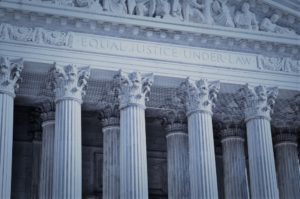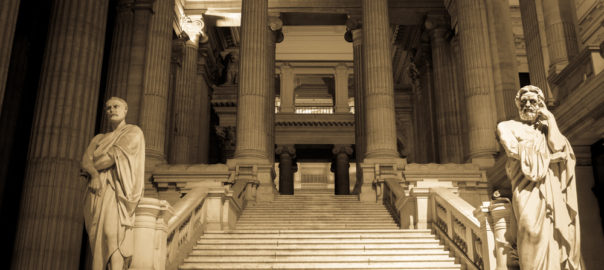Turner v. United States
No. 15-1503
U.S. Supreme Court
Decided on June 22, 2017
Supreme Court Goes Easy on Deceitful Prosecutors but Denies Relief for Petitioners
Issue: Whether, in the context of the entire record, evidence the Government withheld from the defense at trial that would have been favorable to defendants and that would have, in the view of the petitioners, potentially provided an alternative theory contradicting that of the Government meets the materiality standard of Brady.
Holding: The Supreme Court held that the previously undisclosed evidence was not “material” under Brady because petitioners were unable to demonstrate that, had the evidence been disclosed at trial, the outcome of the proceedings would have been different. Relying on the Government’s central theory, the Supreme Court concluded that because the newly discovered evidence contradicted so much testimonial evidence that went to the heart of the Government’s theory, it would have been unlikely the jury would have believed the alternative theory proposed by the petitioners.

Facts: In 1985, the seven petitioners, Timothy Catlett, Russell Overton, Levy Rouse, Kelvin Smith, Charles Turner, Christopher Turner, and Clifton Yarborough were tried together in the D.C. Superior Court for kidnapping, armed robbery, and the murder of Catherine Fuller. At trial, the Government theorized that Fuller had been attacked by a large group of people that consisted of the petitioners, codefendants who were
acquitted, and Calvin Alston and Harry Bennett who confessed to participating in the crime. Alston and Bennett cooperated with the Government and provided testimony that became fundamental to the Government’s argument. Alston and Bennett both confessed they were involved in a group attack, which corroborated with several other witness’ testimonies.
Testimony of Melvin Montgomery: Montgomery testified that he was in a park among a group of people, heard someone indicate they were “going to get that one,” witnessed petitioner Overton point at Fuller, and saw several people, including some petitioners, cross the street in her direction.
Testimony of Maurice Thomas: Thomas, 14 years old at the time, testified that he witnessed the attack and that he knew several defendants. His testimony included recognition of Catlett, Yarborough, Rouse, Charles Turner, Christopher Turner, and Smith at the scene. Thomas also stated he heard Catlett say he “had to kill her.”
Testimony of Carrie Eleby and Linda Jacobs: Eleby, Smith’s girlfriend at the time, and her friend Jacobs testified that they saw several petitioners attacking someone while Yarborough stood nearby after hearing screams from an alley.
Yarborough’s confession: The Government played a videotape of petitioner Yarborough confessing he was part of a large group who committed the crime.
No defendants testified and each maintained that a group attack did not take place. Each petitioner’s strategy was to impeach witnesses who placed them at the scene and others tried to establish alibis. There was no physical evidence at trial.
In 2010, petitioners discovered that the Government possessed certain evidence it had withheld from the defense at trial. Additional withheld evidence was discovered thereafter, which was given to petitioners in the course of petitioners’ post conviction proceedings. The evidence consisted of 1) the identity of a man, McMillan, seen running into the alley after the crime occurred and stopping near the garage where the victim’s body was discovered; 2) a statement of a passerby who allegedly heard groans from a closed garage; and 3) evidence tending to impeach witnesses Eleby, Jacobs, and Thomas. The petitioners claimed the evidence was both favorable and material, entitling them to relief under Brady v. Maryland, 373 U.S 83.
Analysis: Under Brady v. Maryland, 373 U.S. 83 (1963), the Government violates the Due Process Clause of the U.S. Constitution if it withholds evidence that is favorable to the defense and material to the defendant’s guilt or punishment. Here, while the Government conceded the undisclosed evidence was favorable to the defense, it argued that it was not material. Evidence is “material” when there is a reasonable probability that the result of the proceeding would have been different had the evidence not been withheld. Cane v. Bell, 556 U.S. 449-470.
Evidence is material within the meaning of Brady when there is reasonable probability that, had the evidence been disclosed the result of the proceeding would have been different. A reasonable probability of a different result is one in which the suppressed evidence undermines confidence I the outcome of the trial . in other words, petitioners are entitled to a new trial only if they establish the prejudice necessary to satisfy the materiality inquiry.
The analysis that a court must go through is as follows: examine the trial record, evaluate the withheld evidence in the context of the entire record and determine in light of that examination whether there is a reasonable probability that had the evidence been disclosed, the result of the proceeding would have been different.
The petitioners argued that, had they known about the evidence during trial, they could have challenged the group attack theory around which the Government centered their argument and, instead, argued that either McMillan alone or McMillan and an accomplice murdered Fuller.
The Supreme Court found that the withheld evidence in the context of the entire record was too little, too weak, or too distant from the main evidentiary pints to meet the Brady Standard and held that the petitioners were unable to demonstrate a reasonable probability that the result of the trial would have been different had the evidence been disclosed and that the evidence was not material under Brady.
According to the Court, the issue in petitioners’ alternative theory was that they would have had to persuade the jury that Alston and Bennett falsely confessed to participating in a group attack that never occurred; that Yarborough falsely implicated himself in the attack; that disinterested witness, Thomas, wholly fabricated his story; that Eleby and Jacobs falsely testified to witnessing a group; and that Montgomery never saw petitioners and others as a group, identify Fuller as a target and leave the park to rob her. With regard to the undisclosed impeachment evidence, the Supreme Court determined that the record demonstrated that it was largely cumulative of impeachment petitioners already had and used at trial.
Justice Kagan’s Dissent: Justice Kagan framed the issue as follows: the question this case presents is whether such a unified defense relying on evidence unavailable in the fist scenario, had reasonable probability (less than a preponderance) of shifting even one juror’s vote.
With the undisclosed evidence, the whole tenor of the trial could have changed. Rather than relying on a not me, maybe the defense, all the defendants would have relentlessly impeached the Government’s witnesses and offered the jurors a way to view the crime in a different light. And that could have flipped one or more jurors, which is all that Brady requires.
Where the withheld evidence challenged the cornerstone of the Government’s case, then that evidence had game-changing potential. Because the Government withheld evidence the defendants were channeled into accepting the facts as the Government presented them instead of being able to challenge the very core of the case. The Government’s witnesses were not very credible and the evidence was not overwhelming.
